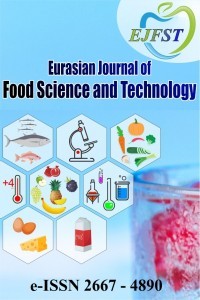Determination of Antioxidant Capacity and Phenolic Content of Tunceli Garlic Extracts (Allium Tuncelianum) By Different Solvents
Determination of Antioxidant Capacity and Phenolic Content of Tunceli Garlic Extracts (Allium Tuncelianum) By Different Solvents
___
- Ağbaş B., Karakuş D., Adigüzel R., Keser S. & Demir E. 2013. Tunceli Sarımsağının (Allium tuncelianum) Toplam Antioksidan Özelliklerinin ve Kuru Madde İçeriğinin Normal Sarımsak (Allium sativum) ile Karşılaştırılması. Bilim ve Gençlik Dergisi 1(2), 2148–2273.
- Apak R., Güçlü K., Özyürek M. & Karademir S. 2004. Novel Total Antioxidant Capacity Index for Dietary Polyphenols and Vitamins C and E , Using Their Cupric Ion Reducing Capability in the Presence of Neocuproine : CUPRAC Method. J. Agric. Food Chem., 52, 7970–7981. https://doi.org/10.1021/jf048741x
- Aykur M., Karakavuk E., Karakavuk M., Akıl M., Can H., Döşkaya M., Gürüz Y. & Dağcı H. 2020. Expert Opinion on Orphan Drugs Inhibitory effect of Tunceli garlic (Allium tuncelianum ) on blastocystis subtype 3 grown in vitro. Expert Opinion on Orphan Drugs, 00(00), 1–8. https://doi.org/10.1080/21678707.2020.1857725
- Firat M. 2015. The Ethnobotanical Usage of Some East Anatolian. Manas Journal of Agricultural and Life Science, 5(1), 80–86.
- Gorinstein S., Leontowicz H., Leontowicz M., Drzewiecki J., Najman K., Katrich E., Barasch D., Yamamoto K. & Trakhtenberg S. 2006. Raw and boiled garlic enhances plasma antioxidant activity and improves plasma lipid metabolism in cholesterol-fed rats. Life Sciences, 78(6), 655–663. https://doi.org/10.1016/j.lfs.2005.05.069
- Gün M. S. 2018. Tunceli sarımsağının (allium tuncelianum) antioksidan aktivitesi oksidatif dna hasarı ve protein oksidasyonu önleyici etkisinin araştırılması. Van Yüzüncü Yıl Üniversitesi, Fen Bilimleri Enstitüsü, Kimya ABD, Doktora Tezi.
- Kang J., Lee S., Kwon H., Kwon M. & NJ S. 2012. Establishment of Extraction Conditions for the Optimization of the Black Garlic Antioxidant Activity Using the Response Surface Methodology. 19(4), 577–585.
- Karaaslan N. M., Ince M., Kaplan Ince O. & Goksin Karaaslan M. 2019. Determination of antioxidant capacity using different acidified solvents and element contents of Allium tuncelianum: A regional and varietal study on endemic edible garlic. Instrumentation Science and Technology, 47(4), 423–435. https://doi.org/10.1080/10739149.2019.1587767
- Keser S., Celik S. & Turkoglu S. 2013. Total phenolic contents and free-radical scavenging activities of grape (Vitis vinifera L.) and grape products. International Journal of Food Sciences and Nutrition, 64(2), 210–216. https://doi.org/10.3109/09637486.2012.728199
- Kiralan M., Rahimi A., Arslan N. & Bayrak A. 2013. Volatiles in an endemic Allium specie: Allium tuncelianum by headspace solid phase microextraction. Journal of Essential Oil-Bearing Plants, 16(3), 417–420. https://doi.org/10.1080/0972060X.2013.813283
- Kizil, S., D. Y. Icgil, and K. M. Khawar. (2014) "Improved in vitro regeneration and propagation of Tunceli garlic (Allium tuncelianum L.)." The Journal of Horticultural Science and Biotechnology 89.4 : 408-414.
- Kollman F. 1983. Flora of Turkey and the East Aegean Islands. Edinburgh University Pres.
- Koyuncu M. & Güvenç A. 1994. Endemic Allium L. species in Turkey. Project No: TBAG-1089. – Ankara: Ankara University, Faculty of Pharmacy.
- Mercan E., Sert D., Karakavuk E. & Akın Ni̇. 2018. Effect of different levels of grapeseed (Vitis vinifera) oil addition on physicochemical, microbiological and sensory properties of set-type yoghurt. International Journal of Dairy Technology, 71, 34–43. https://doi.org/10.1111/1471-0307.12415
- Özhatay N. 2002. Diversity of bulbous monocots in Turkey with special reference. Chromosome numbers. Pure and Applied Chemistry, 74(4), 547–555. https://doi.org/10.1351/pac200274040547
- Özhatay N., Koyuncu M., Atay S., & Byfield A. 1997. Türkiye’nin doğal tıbbi bitkilerinin ticareti hakkında bir çalışma. Doğal Hayatı Koruma Derneği.
- Sarikamiş G., Yanmaz R., Ermiş S., Bakir M. & Yüksel C. 2010. Genetic characterization of pea (Pisum sativum) germplasm from Turkey using morphological and SSR markers. Genetics and Molecular Research : GMR, 9(1), 591–600. https://doi.org/10.4238/vol9-1gmr762
- Singleton V. L., Orthofer R. & Lamuela-Raventos R. M. 1999. Analysis of total phenols and other oxidation substrates and antioxidants by means of Folin-Ciocalteu reagent. Oxidants and Antioxidants., 299, 152–178.
- Woisky R. G. & Salatino A. 2016. Analysis of propolis : some parameters and procedures for chemical quality control Analysis of propolis : some parameters and procedures for chemical quality control. 8839 (October). https://doi.org/10.1080/00218839.1998.11100961
- Wu L. Chen, Chang L. H., Chen S. H., Fan N. Chu. & Ho J. an A. 2009. Antioxidant activity and melanogenesis inhibitory effect of the acetonic extract of Osmanthus fragrans: A potential natural and functional food flavor additive. LWT - Food Science and Technology, 42(9), 1513–1519. https://doi.org/10.1016/j.lwt.2009.04.004
- Yayın Aralığı: Yılda 2 Sayı
- Başlangıç: 2017
- Yayıncı: İlknur BAĞDATLI
Özlem AYDIN BERKTAŞ, Fehmi ODABASOGLU, Fadime ATALAY DUMLU, Zerrin KUTLU, Elif ÇADIRCI, Mesut HALICI, Fazlı ÖZTÜRK, Ahmet ÇAKIR
Environmentally Friendly Bacterial Cellulose Films for Food Packaging
Esin POYRAZOĞLU, Hacı Halil BIYIK, Öznur ÇETİN
Effects of Climate Change on Food Production
Effects of Electrospinning on Antifungal Properties of Thyme and Cardamom Oils
Hilal Nur TEMİR, Funda KARBANCIOĞLU, Filiz ALTAY
Development of Locust Bean Fermentation Bin
Oluwagbotemi EDU, Philip OYENİYİ FAYOSE, Oseni KEHİNDE OWOLARAFE, Olumide FALANA
Effects of Climate Change on Aquaculture Production
John ADANSE, Kate BIGSON, Nkansah ASANTE MAUREEN, Agamba DOROTHY
Abdulkadir BELLO, Nura Isyaku BELLO, Kamaluddeen A. BABA, Ahmad SAİD ABUBAKAR
